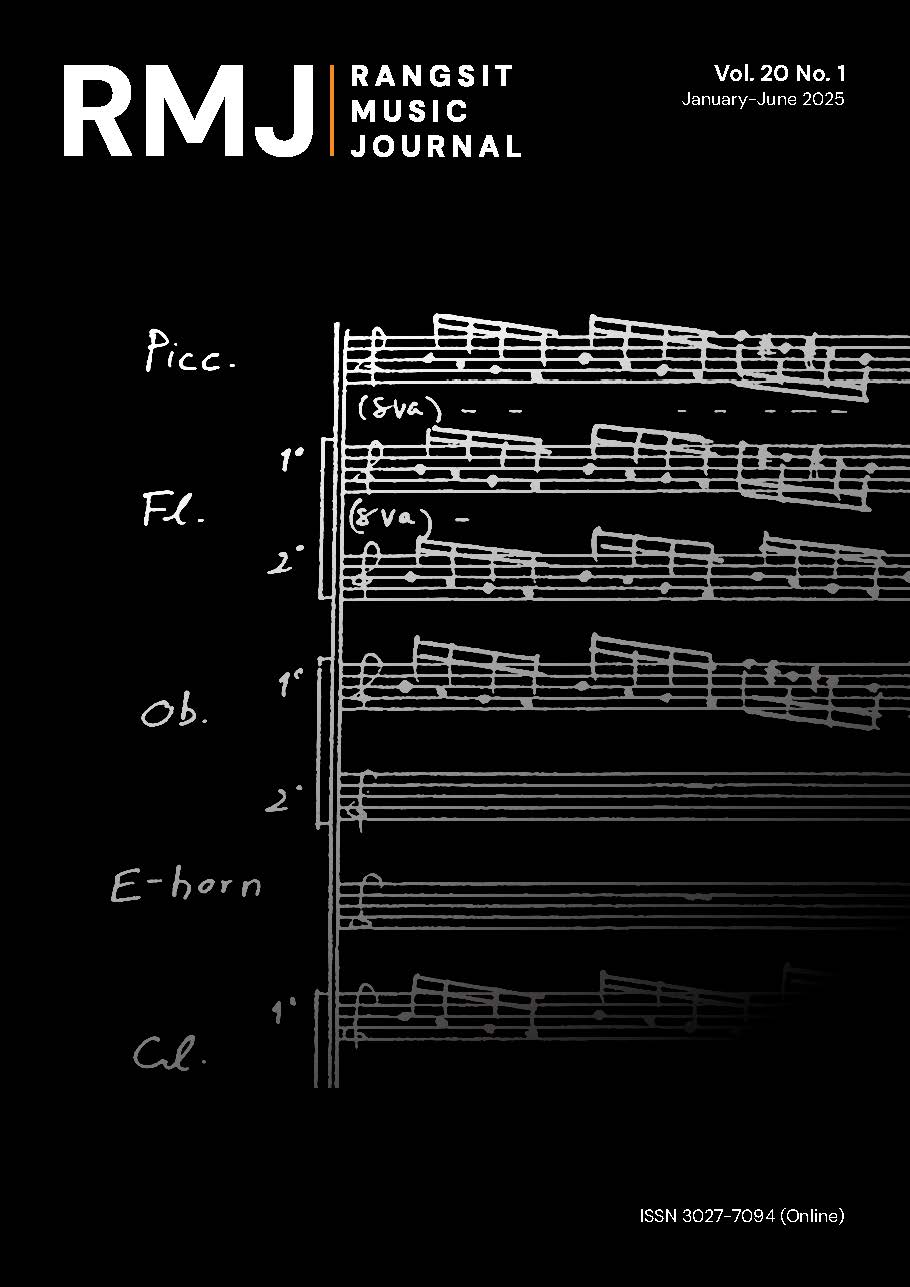Interpretation and Performance Practice on October from The Seasons by Tchaikovsky
DOI:
https://doi.org/10.59796/rmj.V20N1.2025.R0507Keywords:
Piano Recital, October from The Seasons, TchaikovskyAbstract
This research article focuses on the interpretation and performance style of the piece October from The Seasons suite for piano, composed by Pyotr Ilyich Tchaikovsky (1840-1893) from the Romantic period. The main objectives of the study are: 1) to study the biography of Tchaikovsky and the background of the piece; 2) to analyze the musical composition; and 3) to interpret the piece and apply appropriate performance techniques to achieve an accurate and complete rendition. This research aims to provide a guide for future analysis and performance of the piano work for those interested in studying it. The research process includes selecting a suitable piece for performance, reviewing related literature, studying interpretation techniques, practicing the piece, performing a solo piano rendition, and presenting a complete thesis along with publishing relevant articles.
The research findings include an overview of the composer’s biography, the history of the piece, and its interpretation. Tchaikovsky, a renowned composer and pianist from Russia, was proficient in piano and music notation. However, his family initially urged him to pursue a career in law rather than music. Despite this, Tchaikovsky continued to devote his free time to music composition, eventually enrolling at the Conservatory of Music in St. Petersburg. There, he studied orchestration with Anton Rubinstein and piano with Nikolai Rubinstein. His travels across Europe further inspired him, leading to the creation of many famous works, including overtures, symphonies, concertos, piano pieces, and ballets. His music, characterized by rich harmonies, expressive melodies, and profound emotional depth, remains widely celebrated in concert halls and music academies worldwide. Notably, his ballets such as Swan Lake, The Nutcracker, and Sleeping Beauty have become some of the most frequently performed works in the classical repertoire. Tchaikovsky is widely regarded as one of the greatest composers in the world, and his compositions remain widely performed.
Tchaikovsky composed The Seasons in 1875, a suite consisting of 12 short pieces that depict the changing seasons throughout the year in Russia. Each piece has distinct musical characteristics that reflect the atmosphere of its respective month. Tchaikovsky was commissioned by Nikolay Bernard (1844–1905), the editor of a magazine, to compose these short pieces, with Bernard himself writing the accompanying poetic epigraphs for each piece. The 12 pieces in the suite are as follows: December, January, February, and March portray scenes of winter; April and May depict spring; June, July, and August capture the essence of summer; while September, October, and November evoke the imagery of autumn. October, for instance, is written in D minor, in two parts with a 4/4 time signature. The primary theme evokes the cold, quiet ambiance of autumn, symbolizing the passing of the season with a sense of melancholy, loneliness, emptiness, and sorrow. In the performance of this piece, the researcher emphasizes expressing these emotions through soft, continuous sounds, with the melody standing out while the accompaniment and chords remain subdued. Techniques such as free tempo and precise control of dynamics with fingertip articulation are crucial. Practicing slowly and gradually increasing the tempo, along with using the sustain pedal, is essential for conveying the emotional depth and atmosphere of the piece.
The first section of October features a lyrical melody, which should be played with a singing tone and a fluid, expressive touch. The left-hand accompaniment consists of broken chords that should remain delicate and unobtrusive, allowing the right-hand melody to shine. The use of rubato is recommended to enhance the expressiveness of the piece, particularly in phrases that convey longing and nostalgia. Another critical aspect of performing October is pedaling. The sustain pedal should be used sparingly to avoid blurring the harmonies while maintaining a smooth legato. Half-pedaling techniques may be employed to enhance the resonance of sustained notes without over-saturating the sound. Interpretation of October requires an understanding of Tchaikovsky’s compositional style and his ability to evoke vivid imagery through music. His use of chromaticism, subtle harmonic shifts, and expressive phrasing contributes to the nostalgic and contemplative nature of the piece. Comparing different recorded interpretations can provide valuable insights into various performance approaches, helping the performer refine their expressive choices.
In conclusion, the performance of October, with its beautiful yet melancholic melody and free-flowing, imaginative mood, requires a deep understanding of the music. Proper interpretation, combined with technical skill, is necessary to create the correct atmosphere and faithfully present the piece, especially by highlighting the melody clearly and beautifully. An effective performance should balance emotional expressiveness with technical precision, ensuring that the nuances of phrasing, articulation, and dynamic contrast are carefully executed. Ultimately, the ability to capture the essence of October lies in the performer’s sensitivity to the music’s poetic qualities, transforming it from a mere sequence of notes into a deeply moving artistic expression.
References
Akepiriya, Supatcha. “Master Piano Recital by Supatcha Akepiriya.” MA Thesis, Chulalongkorn University, 2022. (in Thai)
Burns, Alex. “Pyotr Ilyich Tchaikovsky: The Seasons, Op.37a, No.10 (October).” Accessed October 5, 2022. https://classicalexburns.com/2021/10/05/pyotr-ilyich-tchaikovsky-the-seasons-october-autumn-song.
Chulapan, Panjai. “Basic Principles in Pianoforte Playing and Piano Playing with Piano Questions Answered.” Rangsit Music Journal 9, 1 (2014): 44-54. (in Thai)
Pancharoen, Natchar. Dictionary of Musical Terms. 5th ed. Bangkok: Tana Press, 2021. (in Thai)
Pancharoen, Natchar. Form and Analysis. 7th ed. Bangkok: Katecarat Press, 2022. (in Thai)
Suttachitt, Narutt. Music Appreciation: Classical Music. 8th ed. Bangkok: Chulalongkorn University Press, 2011. (in Thai)
Downloads
Published
How to Cite
Issue
Section
License
Copyright (c) 2025 Rangsit Music Journal

This work is licensed under a Creative Commons Attribution-NonCommercial-NoDerivatives 4.0 International License.







